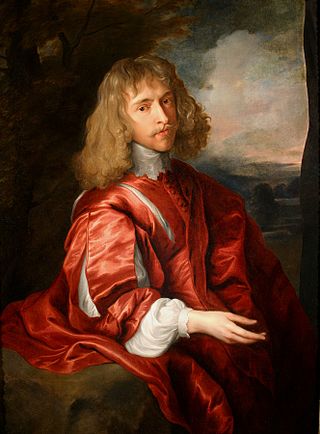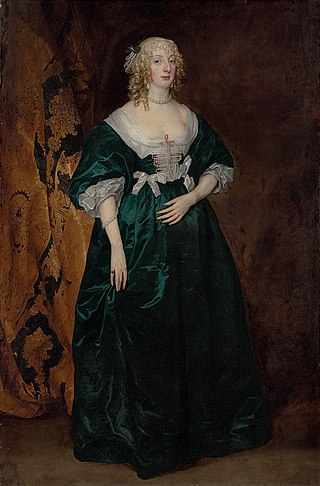
Earl of Chesterfield, in the County of Derby, was a title in the Peerage of England. It was created in 1628 for Philip Stanhope, 1st Baron Stanhope. He had been created Baron Stanhope, of Shelford in the County of Nottingham, in 1616, also in the Peerage of England. Stanhope's youngest son, the Hon. Alexander Stanhope, was the father of James Stanhope, 1st Earl Stanhope, while his half-brother Sir John Stanhope of Elvaston was the great-grandfather of William Stanhope, 1st Earl of Harrington.

Earl of Winchilsea is a title in the Peerage of England. It has been held by the Finch-Hatton family of Kent, and united with the title of Earl of Nottingham under a single holder since 1729.

Earl Castle Stewart, in the County Tyrone, is a title in the Peerage of Ireland. It was created in 1800 for Andrew Thomas Stewart, 9th Baron Castle Stuart.

Earl of Cardigan is a title in the Peerage of England that was created by Charles II in 1661 for Thomas Brudenell, 1st Baron Brudenell, and the title has been held since 1868 by the Marquesses of Ailesbury. Since that time, it has been used as a courtesy title by the heir apparent to that Marquessate, currently Thomas Brudenell-Bruce, Earl of Cardigan, only son of the 9th Marquess.

Earl of Coventry is a title that has been created twice in the Peerage of England. The first creation for the Villiers family was created in 1623 and took its name from the city of Coventry. It became extinct in 1687. A decade later, the second creation was for the Coventry family and is still extant.

Earl of Galloway is a title in the Peerage of Scotland. It was created in 1623 for Alexander Stewart, 1st Lord Garlies, with remainder to his heirs male bearing the name and arms of Stewart. He had already been created Lord Garlies in the Peerage of Scotland in 1607, with remainder to the heirs male of his body succeeding to the estates of Garlies. This branch of the Stewart family were distant relatives of the Stewart Kings of Scotland.

Earl of Buckinghamshire is a title in the Peerage of Great Britain. It was created in 1746 for John Hobart, 1st Baron Hobart.

Earl of Carnarvon is a title that has been created three times in British history. The current holder is George Herbert, 8th Earl of Carnarvon. The town and county in Wales to which the title refers are historically spelled Caernarfon, having been Anglicised to Carnarvon or Caernarvon. The traditional Welsh spelling is itself a modified form of the original name of antiquity, Caer-yn-Arfon, meaning fortification opposite the island of Mona.

Earl of Romney is a title that has been created twice.

Earl of Chichester is a title that has been created three times, twice in the Peerage of England and once in the Peerage of the United Kingdom. The current title was created in the Peerage of the United Kingdom in 1801 for Thomas Pelham, 2nd Baron Pelham of Stanmer.

Earl of Lonsdale is a title that has been created twice in British history, firstly in the Peerage of Great Britain in 1784, and then in the Peerage of the United Kingdom in 1807, both times for members of the Lowther family.

Earl St Aldwyn, of Coln St Aldwyn in the County of Gloucester, is a title in the Peerage of the United Kingdom. It was created in 1915 for the prominent Conservative politician Michael Hicks Beach, 1st Viscount St Aldwyn, known from 1854 to 1907 as Sir Michael Hicks Beach, 9th Baronet, of Beverston. He was Chancellor of the Exchequer from 1885 to 1886 and again from 1895 to 1902. Hicks Beach had already been created Viscount St Aldwyn, of Coln St Aldwyn in the County of Gloucester, in 1906, and was made Viscount Quenington, of Quenington in the County of Gloucester, at the same time he was given the earldom. Both titles are in the Peerage of the United Kingdom. He was succeeded by his grandson, the second Earl, the son of Michael Hicks Beach, Viscount Quenington, Member of Parliament for Tewkesbury, who was killed in action in 1916. Lord St Aldwyn was also a Conservative politician and was Captain of the Honourable Corps of Gentlemen-at-Arms between 1958 and 1964 and 1970 and 1974. As of 2018 the titles are held by his eldest son, the third Earl, who succeeded in 1992.

Viscount Grandison, of Limerick, is a title in the Peerage of Ireland. It was created in 1620 for Sir Oliver St John, the Lord Deputy of Ireland. He was the descendant and namesake of Oliver St John, whose elder brother Sir John St John was the ancestor of the Barons St John of Bletso and the Earls of Bolingbroke. Moreover, St John's nephew Sir John St John, 1st Baronet, of Lydiard Tregoze, was the ancestor of the Viscounts Bolingbroke and the Viscounts St John.

Viscount Fauconberg, of Henknowle in the Bishopric of Durham, was a title in the Peerage of England held by the head of the Belasyse family. This family descended from Sir Henry Belasyse, High Sheriff of Yorkshire from 1603 to 1604, who was created a Baronet, of Newborough in the County of York, in the Baronetage of England in 1611. His son, Sir Thomas, the second Baronet, was created Baron Fauconberg, of Yarm in the County of York, in the Peerage of England in 1627. In 1643 he was further honoured when he was made Viscount Fauconberg, of Henknowle in the Bishopric of Durham, also in the Peerage of England. He was succeeded by his grandson, Thomas, the second Viscount, the son of Henry Belasyse. Thomas was created Earl Fauconberg in the Peerage of England in 1689. He was childless and the earldom became extinct on his death in 1700. He was succeeded in the remaining titles by his nephew and namesake, Thomas, the third Viscount, the son of Sir Rowland Belasyse. The third Viscount was succeeded by his son, Thomas, the fourth Viscount, who in 1756 was created Earl Fauconberg, of Newborough in the County of York, in the Peerage of Great Britain. The Earl's son Thomas, the second Earl, had no sons and the earldom became extinct on his death in 1802. He was succeeded in the remaining titles by his second cousin Rowland Belasyse, the sixth Viscount, the grandson and namesake of Rowland Belasyse, younger brother of the third Viscount. The sixth Viscount was succeeded by his younger brother, Charles the seventh Viscount, on whose death in 1815 all the titles became extinct.

Earl of Sussex is a title that has been created several times in the Peerages of England, Great Britain, and the United Kingdom. The early Earls of Arundel were often also called Earls of Sussex.

Sir Robert Dormer of Wing, 2nd Baronet, 1st Earl of Carnarvon, 1st Viscount Ascott, 2nd Baron Dormer of Wing [or Wenge] was an English peer. He was the son of Sir William Dormer, and thus a grandson of Robert Dormer, 1st Baron Dormer. His mother was Alice Molyneux, daughter of Sir Richard Molyneux, 1st Baronet, and Frances Gerard. Dormer received the title Baron Dormer at the age of six and on 2 August 1628, at age 18, he was raised to Viscount Ascott and was created Earl of Carnarvon.

Sir Charles Dormer of Wing, 3rd Baronet, 2nd Earl of Carnarvon, 2nd Viscount Ascott, 3rd Baron Dormer of Winge was an English peer. On his father's death at the First Battle of Newbury, on 20 September 1643, he succeeded to his father's titles, at just 10 years of age. His mother had died in June, a few months earlier. He married twice, had four children, but his only son predeceased him and so when he died in 1709 the earldom and the viscountcy became extinct. The baronetcy and barony were inherited by Rowland Dormer, 4th Baron Dormer, a grandson of the second son of the 1st Baron Dormer.
Sir Robert Dormer of Wing, 1st Baronet, 1st Baron Dormer of Wing [or Wenge] was a 17th-century English peer.

Villiers is an aristocratic family in the United Kingdom. Over time, various members of the Villiers family were made knights, baronets, and peers. Peerages held by the Villiers family include the dukedoms of Buckingham (1623–1687) and Cleveland (1670–1709), as well as the earldoms of Anglesey (1623–1661), Jersey, and Clarendon. Perhaps the most prominent members of the family were those who received the two dukedoms: George Villiers, 1st Duke of Buckingham (1592–1628) rose to fame and influence as favourite of King James I of England, while Barbara Villiers, Duchess of Cleveland (1640–1709) became a mistress of King Charles II of England, by whom she had five children.

Anna Sophie Dormer, Countess of Carnarvon was an English noblewoman who married Robert Dormer, 1st Earl of Carnarvon and thereby became Countess of Carnarvon. Dormer received the title Baron Dormer at the age of six and on 2 August 1628, at age 18, he was raised to Viscount Ascott and was created Earl of Carnarvon. Anne Sophia died on 3 June 1643 of smallpox.











